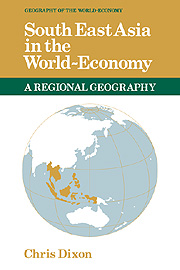Book contents
- Frontmatter
- Contents
- List of figures
- List of maps
- List of tables
- Acknowledgements
- Sources and place names
- List of abbreviations
- 1 Contemporary South East Asia in the world-economy
- 2 Pre-colonial South East Asia
- 3 Western penetration: from trade to colonial annexation
- 4 Uneven development: the establishment of capitalist production
- 5 Development strategies and the international economy
- 6 South East Asia in the late twentieth century: problems and perspectives
- Notes
- References
- Index
3 - Western penetration: from trade to colonial annexation
Published online by Cambridge University Press: 22 September 2009
- Frontmatter
- Contents
- List of figures
- List of maps
- List of tables
- Acknowledgements
- Sources and place names
- List of abbreviations
- 1 Contemporary South East Asia in the world-economy
- 2 Pre-colonial South East Asia
- 3 Western penetration: from trade to colonial annexation
- 4 Uneven development: the establishment of capitalist production
- 5 Development strategies and the international economy
- 6 South East Asia in the late twentieth century: problems and perspectives
- Notes
- References
- Index
Summary
South East Asian trade and Western penetration
The penetration of the Asian trading network by the Western powers was intimately connected with the rise of European capitalism. Thus the distinctive phases in the process reflect the development of the productive forces within those countries that were emerging as the core of the world-economy. The initial penetration by individual traders and, later, companies was the product of mercantile capitalism. This had neither the strength nor the imperative to move from control over South East Asia's external trade to control over territory and direct participation in production. Only in those areas lacking major political structures, for example the Philippines and parts of present-day Indonesia, was direct European control feasible before the nineteenth century. Not until the industrial revolution did the European nations become sufficiently powerful to dominate the major South East Asian states. This chapter sets out the general sequence of European penetration with the objective of illustrating the varied and changing nature of the processes that operated.
Prior to the penetration of the European powers South East Asia held a key position. Trade networks connected East Africa with China and supplied the Middle East, Mediterranean and European world with a variety of high-value goods such as silk, spices, drugs and porcelain. While a wide range of commodities originated in South East Asia, by far the most significant were spices (map 3.1).
- Type
- Chapter
- Information
- South East Asia in the World-Economy , pp. 57 - 84Publisher: Cambridge University PressPrint publication year: 1991

